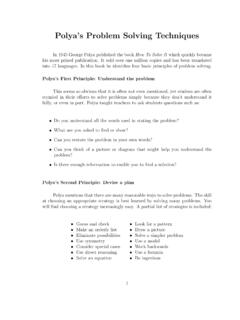Transcription of Chapter 2: Project Life Cycles, Phases, and Process Groups
1 Chapter 2: Project Life Cycles, phases , and Process Groups 2020 Holmes Corporation, All rights 2: Project Life Cycles, phases , and Process GroupsThis Chapter addresses the basics of the Project life cycles, Project phases , and Process Groups . Topic 1 introduces Project life cycles and phases . The second and third topics address life cycles in more detail. Topic 2 presents core concepts of predictive projects, including introducing the Process Groups , while Topic 3 presents the core concepts of agile and hybrid that this Chapter is intended to give you just enough information to put the discussions in this and the next module into a Project management context. The more detailed discussions of Project management processes are reserved for Modules 3 1: Project Life Cycles and Project PhasesA Project life cycle is a series of phases that a Project passes through from its start to its completion.
2 A Project phase is a collection of logically related Project activities that culminates in the completion of one or more deliverables. A life cycle provides a basic framework for managing a Project , and the phases of the chosen life cycle do not change based on the specific Project work projects, even those with just one phase, are typically planned and executed using what is called progressive elaboration. For this reason, this topic starts with a discussion of progressive elaboration. We ll then look at Project life cycles and Project phases in more 2 PREVIEW Distinguish among predictive, iterative, incremental, and agile Project life cycles as well as hybrid approaches. Discover how to split projects into phases to enable incremental value delivery using any type of Project life cycle.
3 Explore what is done during the overlapping Process Groups of Initiating, Planning, Executing, Monitoring and Controlling, and Closing. Understand the Agile Manifesto and the principles that underly agile Project management methodologies. Discover the benefits of learning about unfamiliar Project 1: Business Environment1-20 2020 Holmes Corporation, All rights ElaborationThe PMBOK Guide defines progressive elaboration as the iterative Process of increasing the level of detail in a Project management plan as greater amounts of information and more accurate estimates become available. You need to start planning somewhere even though you know information from other planning areas will influence the part of the plan you are working on.
4 For example, when you are working on the initial schedule and cost estimates, you haven t yet worked on the quality plan or the risk register. Quality control activities and risk responses take time and money, which will either directly impact the schedule and budget or take the form of reserves. Therefore, you will go back and revise these initial plans as you go through the various planning will not start out with perfect estimates. As the relevant events get closer or earlier phases are completed, a more detailed level of information will be available and estimates will be more precise. Since the phases of agile projects are typically very short, the progressive elaboration in this case is meant to occur between each phase. (Changes to plans during a phase are actively discouraged.)
5 Project managers view plan refinement as a natural part of planning that allows more precise baseline specification, measurement, and management as the Project of Life CyclesThere are some common characteristics of Project life cycles that can influence how an organization approaches complex or high-risk projects. Cost and staffing curve. In general, costs and staffing for a predictive Project life cycle are low during the earlier Process Groups Initiating and the first pass at Planning because few team members are on board and the Project is using fewer resources. Costs increase quickly during the later Process Groups of Executing and Monitoring and Controlling, when most of the Project work is being done. Costs begin to decrease at the end of Executing and Monitoring and Controlling as deliverables are completed and resources are released.
6 Costs decrease more quickly during the final Process Group, Closing. On an agile or hybrid Project , early phases may likewise have lower costs if teams start small, and costs could ramp up if the work shows promise and additional resources are devoted to the Project . Teams may also be kept the same size, in which case the cost and staffing curve will be more flat and, as a side benefit, predictable. Stable teams could be small or large ( , to represent many cross-functional interests). Risk/uncertainty curve. In general, uncertainty about a Project s ability to meet its objectives decreases during the Project life cycle. This makes sense. At the beginning of any Project , all risk is in the future. As the Project proceeds, decisions are made, Chapter 2: Project Life Cycles, phases , and Process Groups 2020 Holmes Corporation, All rights and experience increase, and steps can be taken to manage risk more effectively.
7 For example, a predictive Project aiming at producing a new type of manufacturing equipment has more risk during Initiating and Planning, because the sponsor and the Project team don t know how or if the objectives can actually be achieved in proposed designs and if the designs can be translated into production within scope, budget, and time frames. Once a Project is accepted by the customer, no further risk exists. On an agile/hybrid Project , as phases are completed and their deliverables are accepted, the level of risk and uncertainty gradually is reduced. Cost of changes curve. For a predictive Project , the least expensive time to change scope or product characteristics is early on, before work has been done and resources spent. As the Project work progresses, the ability to make changes without significantly affecting cost and schedule (and possibly other measures such as quality and Project team motivation and engagement) decreases.
8 Changing course may mean that investments made as a result of earlier decisions have been wasted. Work based on a mistake or incorporating a flawed element has to be redone. Changes may have a ripple effect on work that has already been completed. A team working on new manufacturing equipment could handle this issue by proving their design concepts through a prototype test before proceeding to building the equipment. (Prototyping is an example of an agile mindset.) This would decrease the risk of later changes to Project baselines. Agile, by design, works to keep the cost of changes lower throughout a Project so that changes can be accommodated even late in the relationship between the anticipated curves for risk and the cost of changes (for a Project on the predictive end of the spectrum) is illustrated in Exhibit 1-3: Risk and Uncertainty Decrease, but Cost of Changes Increases as Project ProgressesSource: Project Management Institute, A Guide to the Project Management Body of Knowledge (PMBOK Guide) Sixth Edition, Project Management Institute, Inc.
9 , 2017, Figure 1-3, Page 549. Material from this publication has been reproduced with the permission of 1: Business Environment1-22 2020 Holmes Corporation, All rights all projects are alike, however. In some projects, costs are front-loaded or rise quickly for example, when a Project requires very expensive architectural planning up front. In some projects, uncertainty is very difficult to manage. For example, a new building may include features that have never been built before or materials that have never been used in construction of this type. To apply heightened levels of managerial oversight, organizations can divide complex predictive projects into more phases , as is discussed at the end of this topic, or they can use iterative, incremental, or agile life cycle types, as is discussed Cycle TypesThe PMBOK Guide mentions four main types of Project life cycles that work for particular types of projects.
10 These are summarized in Exhibit 1-4. There can also be a hybrid life cycle, which combines aspects of all four 1-4: Project Life Cycle TypesSource: Project Management Institute, Agile Practice Guide, Project Management Institute, Inc., 2017, Table 3-1, Page 18. Material from this publication has been reproduced with the permission of of these Project life cycles may manage uncertainty by using rolling wave planning. This is a planning technique in which the work to be accomplished in the near term is planned in detail while future work is planned in a more general manner. The first wave of Project work appears on the horizon, and the team busily prepares to manage it. While that wave dissipates, the team turns its attention to planning its response to the next wave.


